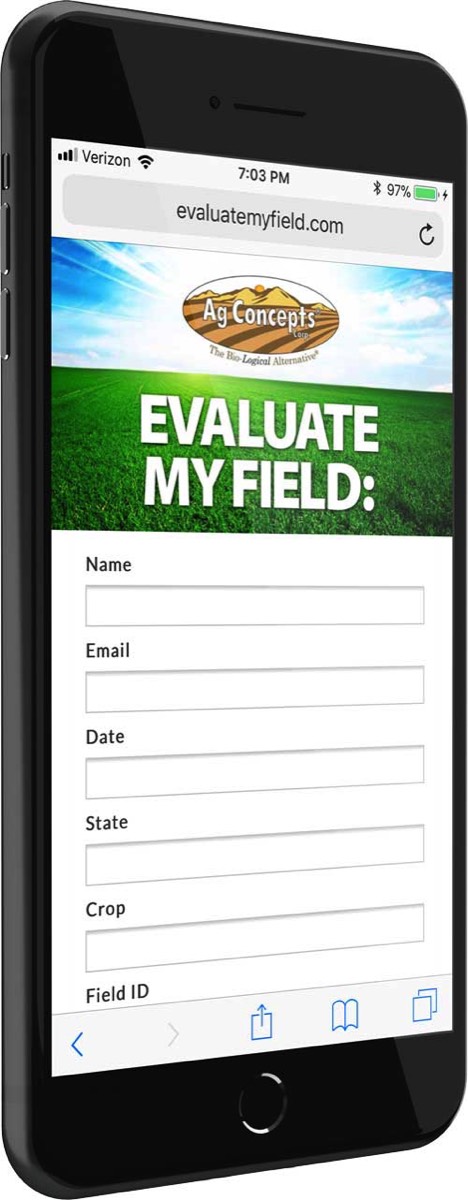
Fill Out the Form Below to Receive the Field Evaluation Form Immediately in PDF Format:

Overview and Philosophy
Every company and every product claims to be able to increase your yield and bring you an incredible harvest every year. If all the claims were true you would have a record yield every year! The problem is that most products simply don’t work, and growers have been taken advantage of by a history of companies making questionable scientific claims and promising the next big thing. Commonly after a grower tries a new product they will not see the company rep until the following season when it is time for the next sale. Simply put, the rep does not take the time to examine the crop response to the product.Like many companies, Ag Concepts has invested into yield testing at private testing and research stations. In fact, our products have been tested with hundreds of fertility programs, on dozens of crops, in over 30 states, on 5 continents, in all soil types, in wet seasons and drought, and the results consistently show an increase in yield. But, what impacts you is the results you see on your land. This is where Ag Concepts is different: our focus is on showing you the crop response in your field – especially those that you cannot see on a yield monitor.
Keep in mind that when you use products like those manufactured by Ag Concepts, your ground, soil, and crop will respond in many ways. And many of those responses do not simply show up as increased yield every year. For instance, one response to AgZyme many crops show is increased root mass. However, increased root mass does not necessarily lead to increased yield, and increased root mass has many other positive effects on the soil ecosystem. Increased root mass helps yield potential when the plant is under stress situations like drought and disease. But without stress, yield response may not be observed. Increased root activity also helps increase soil microbial activity, which over time helps improve soil structure. If yield is the only metric observed and the plant does not undergo stress, then many of the benefits of AgZyme may be overlooked.
Ag Concepts trains our representatives and encourages users to look at more responses than simply yield, and to keep the long term effects in mind. Our philosophy is to evaluate metrics like biomass, disease pressure, percent water filled pores and soil texture to get an overall measure of field response to product application. This type of evaluation leads to a better understanding of the efficiencies in the growing system and helps growers make decisions based on data.
Field Evaluations are the key to determining if you have a product that is a good tool for production. Ag Concepts representatives are trained to do multiple field evaluations throughout the growing year; they will be in your fields looking at crop response. Another great way to build your own confidence in Ag Concepts’s products is to do field evaluations personally. By following the concepts addressed in this guide you will be able to make data based decisions to increase the overall efficiency of your production system.
Data – The Key to Field Evaluations
The accurate collection and evaluation of unbiased, objective, measurable data is the key to accurate field evaluations of crop response. The more data the better, so data collection becomes a time restricted activity. We encourage three to four evaluations per year, five to ten locations in the field, equal numbers of locations in treated and untreated areas, three to ten samples per location, and multiple measurements per sample.This can become very time intensive late in the season, so discretion is necessary. Collecting data in a potato field shortly after emergence is significantly easier than collecting data after row closure. So, be sure to get into the field early in the growing season and collect more samples at that time. A late season potato evaluation may be limited to only three samples in three to five areas in a field simply due to the time and effort involved in data collection.
Unbiased, objective, measurable data is data that can be represented by a number, is determined from a predesigned plan, and is collected from random samples. To keep data unbiased, the field evaluation plan should be determined before arriving at the field. Determine how many areas will be sampled, how many samples will be collected, and what metrics will be measured. Once in the field, make a plan to sample areas representing as much of the field as possible. Bias is also eliminated by repeating measurements, making three to ten samples in five to ten areas of the field necessary.
Some metrics are somewhat subjective, like observations of vigor and disease pressure. Make these observations as objective as possible by determining a ranking strategy before entering the field and staying consistent. There is no reason to skew data, good decisions are based on good data.
Measurable data is data that can be represented with a number. This eliminates observations based on feel, color, sight, smell or other subjective values. Good metrics of measurable data are height, weight, circumference, length, and objective ranking. These measurements can then be evaluated with by calculating averages and standard error for a truly accurate picture of field response.
Data Evaluation
After data collection is completed, the numbers are used to calculate two values that can then be compared and tracked through seasons and years to truly determine if a response occurred. One challenge of field evaluations is “background noise”, the natural variability in a field. By taking multiple samples and calculating the Standard Error, we can begin to account for background noise and make a decision about the overall crop response.Ag Concepts has developed a tool to make your data evaluation quick and easy. Simply go to EvaluateMyField.com and enter your raw data. You will immediately be emailed a report with a chart comparing the treated and untreated average of the metric entered (vigor, plant height, etc.). The Standard Error is included on the graph as error bars. If the treated and untreated values are different and the error bars do not overlap, your crop response was likely due to the product applied.
Corporate Office:
439 East Shore Drive., Suite 200
Eagle, ID 83616
(208) 388-1131
439 East Shore Drive., Suite 200
Eagle, ID 83616
(208) 388-1131
Manufacturing Plant:
17285 US Highway 30
Bliss, ID 83314
17285 US Highway 30
Bliss, ID 83314

